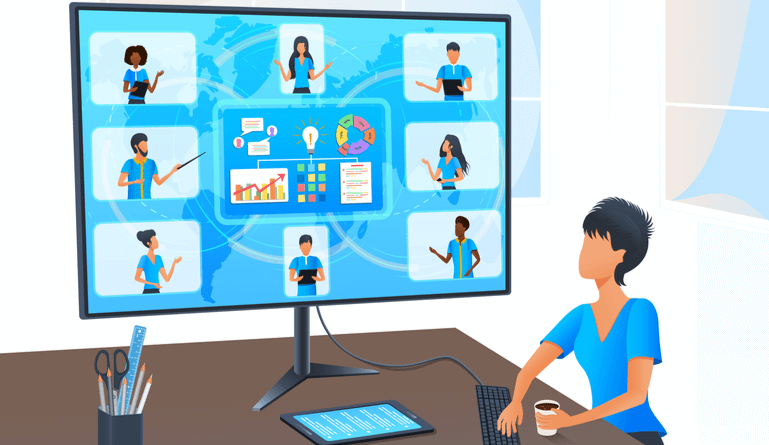Work from home became the new normal during the post-covid period, causing a paradigm shift in organizational behavior and work culture. To resist the thrust, buoyant conglomerates adopted the concept of virtual teams and virtual leadership during COVID to manage the anticipated damage of man and money. These companies mandated their workers to work from home worldwide and initiated a virtual leadership trait to establish momentum in the face of adversity. As per the research, remote workers can be 20 to 25 percent(1) more productive than their onsite colleagues when coupled with effective virtual leadership.
Work-from-home challenges that underscored the importance of Virtual Leadership
Because it is simple to deviate from the path while working on the internet, it becomes crucial to create a project plan and follow it to the fullest. This discipline can be achieved by following predetermined rules or processes that enable virtual leaders to identify and eradicate the cause of the decline in productivity.
Employees first found work from home to be a bit tough because homes were often regarded as a place to retire after a long hectic day at work. On the other hand, a clearly defined routine allowed them to maintain the same office discipline and quickly return to work.
According to Gartner(2), 74% of companies have planned to transfer their employees to permanent remote worker status. This confirms that working from home is beneficial when virtual teams use digital tools in conjunction with virtual leadership activities to achieve outstanding results.
Establishing a virtual structure include
-
Virtual team building activities
Virtual leaders, like traditional leaders, focus on developing a dynamic virtual team by assessing and assigning the roles and responsibilities to remote team members. They prioritize building and fostering relationships.
-
Reliable and time-bound communication network
To collaborate effectively in a virtual office, access to the necessary technologies and proper digital communication is mandatory and indispensable. The virtual team equips itself with necessary digital equipment such as phones, webcams, and Instant messaging tools.
-
Incorporation and use of relevant Apps and tools
Virtual leaders select specific software tools to synchronize, deliver, monitor, motivate, and guide remote teams toward a common goal while saving time and energy.
Once the virtual structure is in place, the protocol takes over, allowing effective leadership routines to surface
-
Strategic Project Planning and Progression
Feasibility studies, project planning, and milestones for project progression assist virtual leaders in determining the project’s evolution trajectory. This planning schedule evaluates the project’s progress considering team performance.
In work from home scenario, proper planning can conserve time, money, and resources. It can boost flexibility and improve Transparency. Strategic planning sets the tempo of the workforce. It enhances team value, cooperation, and production.
By using strategic planning tools like Jira(3), managers can envisage results, set a deadline, and adopt tactics to bring out the best of each individual in the team.
-
Ensure Agility and Availability
To affirm productivity, virtual leaders formulate work schedules considering internal and external influencers. A substantial part of an efficient routine includes abidance to specific protocols, quick reach, and flexibility lead the scoreboard. According to the Future of Work survey(4), 78 percent of the respondents referred to flexible schedules and telecommuting as effective and productive.
Because the team frequently seeks close collaboration and decisions to go further on an assignment, being available to answer concerns helps in the efficient management of projects.
Setting up a to-do list that specifies all of the work to be done for that given day according to priority can help all the contributors achieve flexibility.
Evernote(5), Trello(6), and Monday(7) are some of the best task management tools available. They’re multi-device cloud-based utilities that let you manage individual To-Do lists from anywhere and thus ensure availability and flexibility.
-
Establish Comprehensive Communication Routine
In the absence of an effective communication model, teams struggle to achieve their goals. In a work from home setting, a communication breakdown might be disastrous. This gap could be effectively bridged when the virtual leadership implements an appropriate communication channel and frequently corresponds with their teams through emails, communication websites, calendar invites, chat, or phone calls.
A handy tool such as Slack(8) can help uninterrupted communication. Virtual leaders can also communicate with their co-workers via video conferencing and also access remote desktops via Anydesk(9). Chats, voice calls, and screen sharing among team members work seamlessly with Skype(10) and Google meet(11).
-
Implement Task management Tools to Keep Projects on Track
Project tracking is a project management technique for keeping track of progress besides monitoring project status, issues, and available resources. This routine enables the virtual leaders to compare actual progress to projected progress and identify concerns that may avert the project from staying on schedule and within budget.
It also helps in managing the entire team’s work in one place and improves accountability.
Effective virtual leadership advocates using a project management system application like HubSpot(12) or Zoom(13) to easily collaborate between segments, manage projects and monitor a team’s real-time workflow.
-
Track Remote Employee Productivity and KPI’s
The pragmatic approach establishes that home lethargy and internet distractions cause significant loss of concentration and alertness, impacting remote employees’ performance. Hence a Work from Home (WFH) Performance Management Routine or KPIs is devised to track and measure the remote worker’s ability to succeed outside the office environment.
Key Performance Indicators (KPIs) for a team member allows the team leaders to assess each team member’s productivity and, if necessary, take remedial action to boost production. The virtual leaders also need to create a policy for assigning milestones to each task an employee is responsible for delivering.
The inclusion of software such as WebWork Tracker(14) regulates accountability, self-discipline, the integrity of an individual employee in the virtual team.
-
Capture Employee Feedback and Encourage Transparency
A solid and constructive feedback system laid by the virtual management makes the remote employee feel appreciated. Constructive criticism is also a valuable tool virtual management can apply to help the team raise their benchmarks.
Virtual Leaders have to formulate a routine to develop a foundation of Transparency, trust, and loyalty by showing the distant employees how much the company values their contributions and ideas.
Constructive feedback, made possible by software like Empuls, clarifies expectations, helps people learn from their mistakes, and promotes self-esteem.
-
Establish Periodic, Meeting, training, and reporting sessions
The goal of all forms of the meeting is to go through the essential tasks that are done or are in progress or are about to be started. Daily, Standup meetings and weekly reporting play a critical role in the work from home culture. They are a helpful way to track workflow and project completion status. When the team meets regularly, the workflow becomes more consistent, and the virtual leader gets an opportunity to set the tone of the day.
Online training and presentation for virtual teams have opened new dimensions of growth even in the restricted environment of lockdown and WFH. Virtual leaders concentrate on three areas: technology, group processes, and cross-cultural management while developing the routine of online training.
Weekly reporting and video conferencing induce team spirit, collaboration, and healthy competition among the team members.
Software tools such as Zoom(15) calls have become an integral part of the virtual leadership routine and gain much importance in the business world post-Covid situation.
Final Thought
The virtual leadership routines and their efficacy does not end here. We have heard a lot about the impact of social media on society, but statistics on remote work demonstrate that technology has drastically revolutionized the employment sector. In fact, 36 percent utilize a cloud-based management solution of some kind, and instant messaging service is used by 34 percent of people, besides 13 percent use collaboration software.
The integration and dominance of technology in workforce management have expanding to bring in more opportunities and threats. And therefore, the virtual structure and virtual leadership will have to bear much more roles to play and responsibilities to deliver in the coming future.






